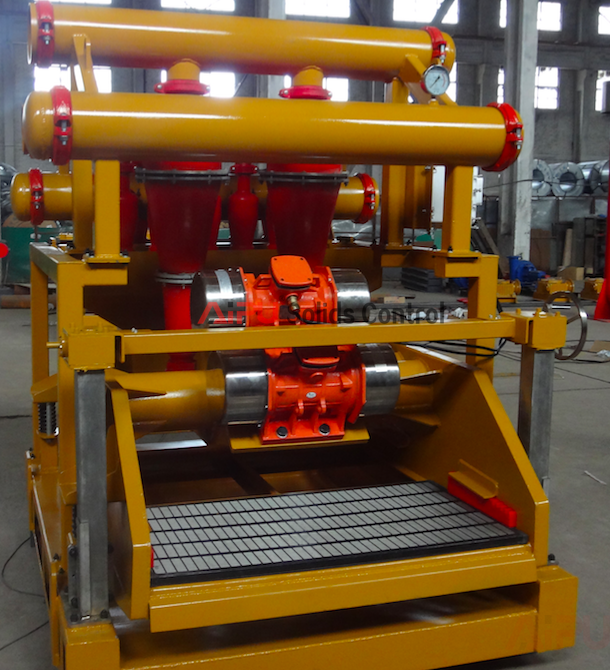Oilfield solids control mud cleaner history and use
The combination of hydrocyclones and bottom shaker screen also called three in one. As there is desander, desilter and the shale shaker.
Mud Cleaner History
We thought 1970s is the first time mud cleaner invented into oil well drilling. When mud cleaners were invented in 1970's, main shale shakers on drilling rigs were either unbalanced elliptical or circular motion machines. The finest screen at that time could separate solids only larger than about 177 microns (API 80) from a normal drilling-rig circulating rate. But now, we have many new generation shaker, the linear motion and BEM shaker. Besides, the shaker screen are fit with much finer mesh, such as API 230, API 300, even more. Barite specifications restricted solids to sizes predominantly smaller than 74 microns (API sand). Hydrocyclones removed large quantities of barite from a weighted drilling fluid and were not generally used.
 The first mud cleaner was a combination of two 12-inch-diameter and twenty 4-inch hydrocyclones mounted above a specially built, 5-foot- diameter, stainless steel, round Sweco shaker. Even though the mud cleaner was invented for use with a weighted drilling fluid, the first application was on a well drilled using one of the first unweighted, potassium chloride drilling fluids, in a shallow, 2200-foot research well. An API 80 screen was mounted on an unbalanced elliptical motion Linkbelt shale shaker to process the fluid as it left the well bore. The fluid was then pumped to the hydrocyclones. The second mud cleaner was a bank of twenty 4-inch Pioneer hydro- cyclones mounted above another specially built 4-foot-diameter, double- deck, stainless steel, round Sweco shaker.
However, we found as early as 1800s there was a mud cleaner invented by German people. But no matter how, the wide recognize on mud cleaner began from 1970s and by now, it shared over 40 years development
The first mud cleaner was a combination of two 12-inch-diameter and twenty 4-inch hydrocyclones mounted above a specially built, 5-foot- diameter, stainless steel, round Sweco shaker. Even though the mud cleaner was invented for use with a weighted drilling fluid, the first application was on a well drilled using one of the first unweighted, potassium chloride drilling fluids, in a shallow, 2200-foot research well. An API 80 screen was mounted on an unbalanced elliptical motion Linkbelt shale shaker to process the fluid as it left the well bore. The fluid was then pumped to the hydrocyclones. The second mud cleaner was a bank of twenty 4-inch Pioneer hydro- cyclones mounted above another specially built 4-foot-diameter, double- deck, stainless steel, round Sweco shaker.
However, we found as early as 1800s there was a mud cleaner invented by German people. But no matter how, the wide recognize on mud cleaner began from 1970s and by now, it shared over 40 years development
Different mud cleaner use
The principal use of
mud cleaner has always been the removal of drilled solids larger than barite. Sufficient drilling fluid bypasses shale shaker so that even with 74-micron (API 200) screens on the shaker, many drilled solids are removed from a weighted drilling fluid. When linear motion shakers permitted API 200 screens to process all of the rig flow mud cleaner usage declined rapidly. However, whenever a mud cleaner was used downstream, the screens were loaded with solids. Verification of larger solids bypassing the shale shaker has been evident from the prevalence of plugged desilters on a rig. Plugged desilters are very common. Usually, no one is assigned to unplug desilters, so they do not get unplugged.
A secondary use of mud cleaners is the removal of drilled solids from unweighted drilling fluids with a very expensive liquid phase—such as the initial application with the potassium chloride drilling fluid. In this case, the underflow from desilters is screened to remove solids larger than the screen opening. Solids and liquids pass through the screen and remain in the system. This is beneficial for nonaqueous drilling fluids as well as saline water–base drilling fluids.

In unweighted drilling fluids, the desilter underflow could be directed to a holding tank. A centrifuge could separate the larger solids for discard and return the smaller solids and most of the liquid phase to the drilling-fluid system. This method is easy to apply if a centrifuge is already available on a drilling rig. More drilled solids would be rejected by the centrifuge than by the mud cleaner screen; however, renting a centrifuge for this purpose may be more expensive. Both techniques have been used extensively in the field.
Locating mud cleaner in drilling fluids system
Mud cleaners are normally positioned in the same location as desilters in a drilling fluid system. Frequently, the desilters, or hydrocyclones are used in the unweighted portion of a borehole by diverting the underflow away from the mud tanks. When a weighting agent, barite or hematite, is added to the system, screens are placed on the mud cleaner shakers. Solids discarded from the hydrocyclones are sieved to discard solids mostly larger than barite and return solids smaller than the screen size with most of the liquid phase. Practical tip: Barite goes in, screens go on.
Another method has been used to create a mud cleaner using the main shale shaker, mostly on offshore rigs. When several linear, or balanced elliptical, shale shakers are needed to handle flow in the upper part of a well bore, fewer shakers can handle the flow after the hole size decreases and the mud weight is increased.

